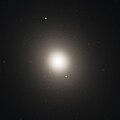Dosya:M105.jpg

Bu önizlemenin boyutu: 600 × 600 piksel. Diğer çözünürlükler: 240 × 240 piksel | 480 × 480 piksel | 985 × 985 piksel.
Tam çözünürlük ((985 × 985 piksel, dosya boyutu: 38 KB, MIME tipi: image/jpeg))
Dosya geçmişi
Dosyanın herhangi bir zamandaki hâli için ilgili tarih/saat kısmına tıklayın.
| Tarih/Saat | Küçük resim | Boyutlar | Kullanıcı | Yorum | |
|---|---|---|---|---|---|
| güncel | 14.37, 22 Ekim 2017 |  | 985 × 985 (38 KB) | Fabian RRRR | {{Information |Description=Messier 105 M105 (aka NGC 3379) - Hubble peered into the core of M105 (also known as NGC 3379) and measured the motions of stars swirling around its center. These observations proved that a supermassive black hole resides at... |
Dosya kullanımı
Bu görüntü dosyasına bağlanan sayfa yok.
Küresel dosya kullanımı
Aşağıdaki diğer vikiler bu dosyayı kullanır:
- de.wikipedia.org üzerinde kullanımı
- pl.wikipedia.org üzerinde kullanımı
- ru.wikipedia.org üzerinde kullanımı
- sv.wikipedia.org üzerinde kullanımı
- th.wikipedia.org üzerinde kullanımı
